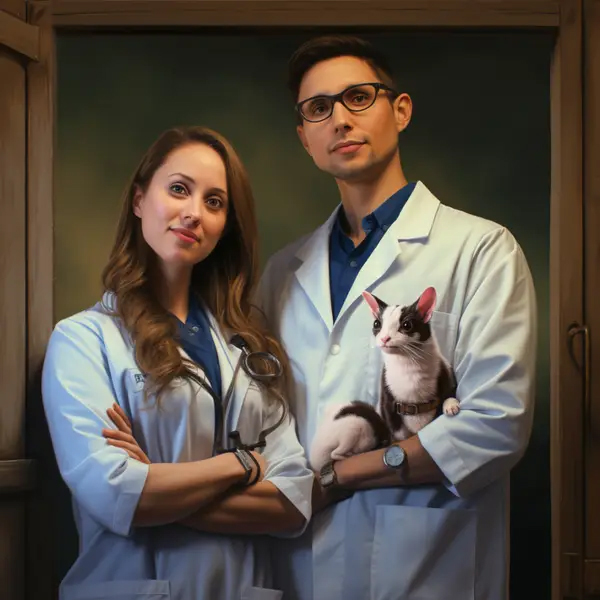Unveiling the Hidden Biases: Exploring Stereotypes in AI-Generated Images of Healthcare Professionals
Artificial Intelligence (AI) has undoubtedly revolutionised various industries, including healthcare. However, as we delve deeper into the capabilities and limitations of AI, it becomes crucial to acknowledge the biases and stereotypes that can emerge in its generated content. In this blog post, we'll examine a series of AI-generated images portraying doctors, nurses, dentists, veterinarians, and paediatricians. These images serve as a thought-provoking reminder of the current state of AI and the need for increased diversity and fairness within its models.
Unveiling the AI-Generated Images: The images presented here were created using generative AI algorithms, designed purely for entertainment and curiosity. It is important to emphasise that these images should not be perceived as accurate representations of real professionals or comprehensive depictions of human experiences. Instead, they offer a glimpse into the current biases embedded within AI models.

1. AI-Generated Image of Doctors: The AI-generated image of these two doctors showcases a younger-aged woman wearing a white lab coat with a stethoscope around her neck, and a middle-aged man also with a stethoscope wearing a suit and tie overlaid with a blue scrub jacket. While the image represents a common perception of doctors, it reinforces the stereotypes typical of Hollywood. On a positive note, Ai has considered doctors from diverse backgrounds and genders, acknowledging the significant contributions of women and professionals from various ethnicities in the medical field.

2. AI-Generated Image of Nurses: The AI-generated image of two nurses presents a young woman in a neutral beige coloured uniform, looking rather sombre and a male nurse in Burgundy coloured scrubs with a look of determination. While nursing is a predominantly female-dominated profession, it is crucial to avoid reinforcing gender stereotypes. The AI-generated image also did well not portraying nurses solely as young women, and neglecting the diverse range of individuals who contribute to the nursing profession. Emphasising the importance of showcasing male nurses, older professionals, and individuals from different cultural backgrounds is essential for fostering inclusivity.

3. AI-Generated Image of Two Veterinarians: The AI-generated image of veterinarians features a young-looking male veterinarian holding a unique-looking cat, while the female veterinarian is young and attractive. Both vets look professional and are easily recognisable as veterinarians. Although this image captures the essence of animal care, it overlooks the diverse roles and responsibilities that veterinarians undertake. Veterinarians work with a variety of animals, including livestock, exotic species, and wildlife. Highlighting this diversity in AI-generated images would contribute to a more comprehensive representation of the veterinary profession.

4. AI-Generated Image of Dentists: The AI-generated image of these two dentists depicts a woman wearing a white coat with a pen in the top pocket. We think that the image does not accurately represents the attire and tools commonly associated with dentistry, and it fails to encompass the full range of dental professionals. Dentistry comprises a wide spectrum of specialists, including orthodontists, oral surgeons, and periodontists. By showcasing a broader representation of dental professionals, AI models can reflect the diversity within this field.

5. AI-Generated Image of Paediatricians: This AI-generated image of two paediatricians displays a male and female doctor wearing white coats and a warm inviting smile to demonstrate trust. While it captures the caring nature often associated with paediatricians, it perpetuates a stereotype typical of paediatricians. On the plus side, gender and ethnic diversity have been considered. Ensuring that AI-generated images of paediatricians encompass a variety of genders is crucial for challenging gender biases and providing a more accurate representation of this specialised medical profession.
While AI-generated images of healthcare professionals provide intriguing insights, they may also reveal biases and limitations that need to be addressed. By promoting diversity and inclusivity in AI models, we can foster a more accurate and comprehensive representation of people. It is imperative that AI development prioritises fair and inclusive practices to challenge stereotypes and promote a more equitable future for all professions.
Challenges in Diversity: One observation from most AI-generated images is the lack of diversity among healthcare professionals. Representation matters, and it is disconcerting to see the underrepresentation of various ethnicities, genders, and body types in these images. It highlights the urgent need to address the biases in AI training data and ensure a more inclusive approach to AI development.
Gender Stereotypes: Another issue apparent in many AI-generated images is the reinforcement of gender stereotypes. Female doctors are predominantly depicted in nurturing and caregiving roles, perpetuating traditional gender norms. Conversely, male healthcare professionals are often portrayed in authoritative positions, reinforcing gender biases that have plagued our society for far too long.
Addressing the Biases: As we move forward, it is crucial to acknowledge and rectify the biases present in AI-generated content. Developers and researchers must actively diversify training data to ensure fair and accurate representation across all domains. Including diverse perspectives and experiences in the development process can help mitigate biases and promote inclusivity.
The Power of Ethical AI: AI has the potential to transform healthcare, but it must be developed and deployed ethically. It is essential for AI developers and researchers to prioritise fairness, diversity, and inclusivity. By promoting transparency and accountability, we can work towards a future where AI models represent the rich tapestry of human experiences without perpetuating harmful stereotypes or biases.
Addressing Biases in AI Towards an Inclusive and Equitable Representation of Healthcare Professionals: The AI-generated images of healthcare professionals presented here serve as a valuable reminder of the biases and stereotypes that persist within AI models. By recognising these limitations, we can work towards building a more equitable and inclusive AI ecosystem. As AI continues to evolve, let us strive for an AI that accurately represents and serves all individuals, regardless of their gender, race, or background.






